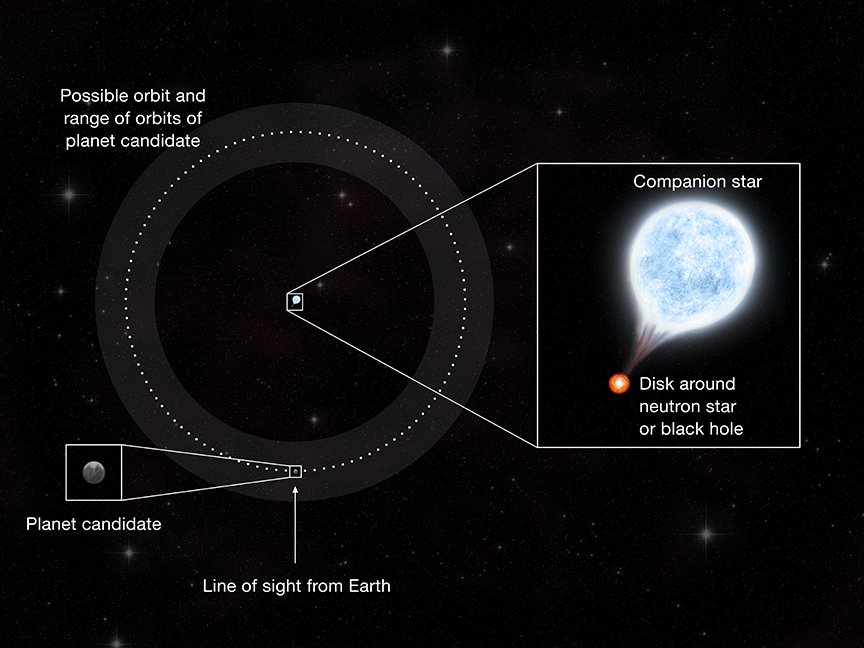Astronomers may have discovered the first-ever exoplanet outside our milky way galaxy. The exoplanet candidate is found in the galaxy Messier 51, also known as the Whirlpool Galaxy due to its unusual profile.
The location of the possible extragalacitc exoplanet - Image credit: X-ray: NASA/CXC/SAO/R. DiStefano, et al.; Optical: NASA/ESA/STScI/Grendler; Illustration: NASA/CXC/M.Weiss - (Click on image to enlarge)
An extragalactic exoplanet
Planets outside of our Solar System are known as exoplanets. Up until now, scientists have discovered all known exoplanets and exoplanet candidates in the Milky Way galaxy itself, nearly all of them within 3,000 light-years of Earth for that matter. To put this in perspective: exoplanets in Messier 51 would be located at a distance of 28 million light-years, which is thousands of times further away. This is an almost incomprehensible distance, we recommend our article on the vast distances in space to get your head around it.
According to astronomer Rosanne Di Stefano, lead author of the study that describes this discovery, she and her team are attempting to pioneer an entirely new arena for detecting exoplanets by looking at X-ray wavelengths. This method enables scientists to look much further, even in other galaxies.
The team augmented the conventional transit method of detecting exoplanets by looking at dips in visible starlight when a planet passes in front of a star, blocking some of its light. Instead of dimming starlight, the team looked at dips in the brightness of X-rays received from bright X-ray binaries, using data from the Chandra space telescope.
Usually, these ‘X-ray binaries’ consist of black holes or neutron stars that pull in gas from an orbiting star creating x-rays in the process.
Illustration of the Chandra X-ray Observatory, an extremely sensitive x-ray telescope - Image Credit: NASA/CXC/NGST
Because the zone in which brilliant X-rays are generated is very small, a planet passing in front of it might block most or all of the X-rays, making the transit easier to identify. This is why exoplanets can be discovered at considerably larger distances compared to existing optical light transit methods, for which the capacity of detecting minute changes in light is needed as a potential exoplanet will only block a portion of the star's light.
Researchers utilized this strategy to find an exoplanet candidate in M51-ULS-1, a binary system in Messier 51. At this location, a black hole (or neutron star) is orbited by a companion star with a mass of nearly 20 times that of our Sun.
The team discovered a three-hour X-ray transit during which the X-ray output dropped to zero. The researchers believe that the exoplanet candidate in M51-ULS-1 is approximately the same size as Saturn and orbits the neutron star or black hole at nearly twice the distance Saturn orbits the Sun.
Illustration depicting the extragalactic exoplanet system - Image Credit: NASA/CXC/M. Weiss
While this is intriguing research, additional evidence is needed to confirm the interpretation of the planet as an actual extragalactic exoplanet. One problem is that the candidate planet’s huge orbit means it won't cross in front of its binary partner for another 70 years, thereby putting an end to any attempts at confirmation for decades.
The research team will go through the Chandra and XMM-Newton archives for other exoplanet candidates in other galaxies. There are at least 20 galaxies for which large Chandra datasets are available, including a few that are significantly closer than Messier 51, such as Messier 31 and Messier 33, allowing for the detection of shorter transits.
Another intriguing area of inquiry is looking for X-ray transits from X-ray sources originating within the Milky Way itself in order to find new planets in strange surroundings.
We, for one, look forward to whatever findings they may uncover!
Sources and further reading:
Astronomers discovered that there m,ay be countless hidden 'exo-earths' (Universal-Sci)
Accelerating exoplanet discovery using chemical fingerprints of stars (Universal-Sci)
A possible planet candidate in an external galaxy detected through X-ray transit. (Nature Astronomy)
Chemical analysis of first-ever detected transiting exoplanet surprises astronomers (Universal-sci)
If you enjoy our selection of content, consider subscribing to our newsletter - (Universal-Sci Weekly)
FEATURED ARTICLES:










